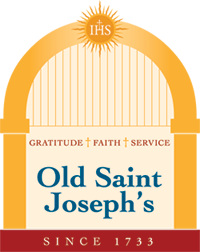19th Century
Old St. Joseph’s In The 19th Century
The lack of priests in the new nation, in addition to the suppression of the Society Jesus in 1773, forced the Jesuits to withdraw from Philadelphia in 1799, although Philadelphia continued to be a center of Catholicism under the leadership of European priests recruited by Bishop Carroll. Among the notable priests who served Old St. Joseph’s during this time were Fr. Francis Fleming, O.P., and Fr. Matthew Carr, O.S.A, both of whom became Vicars General for Bishop Carroll; Fr. Terence Donaghue, founder of St. Michael’s Church and later Vicar General of Iowa; and Fr. John Hughes, founder of Philadelphia’s St. John the Evangelist Church and later bishop of New York and builder of St. Patrick’s Cathedral. After Philadelphia became a diocese in 1808, the clergy house was the site of diocesan governance and the residence of Philadelphia’s first two bishops, Michael Egan, O.S.F., (d. 1814) and Henry Conwell (d. 1842). In 1833, after the restoration of the Society of Jesus and one hundred years after the erection of Father Greaton’s chapel, the Jesuits reclaimed their patrimony at Old St. Joseph’s. The return of the Jesuits brought new energy to a struggling diocese in a nascent American Church, which was still considered a mission church by the Vatican. The American Jesuits were no longer circuit riding missionaries in a rural society but builders of a Catholic Church marked by America’s increasing immigration, urbanization and industrialization The Jesuits who served OSJ after 1833 were men of distinction. The first to arrive was Rev. Stephen Dubussion, S.J., a Frenchman. A cultured member of the minor nobility who spoke four languages, he brought vestments and altar furnishings given by wealthy benefactors to Old St. Joseph’s. He was followed in 1837 by Rev. James Ryder, S.J., who later became Provincial of the Maryland Province and president of Georgetown College, College of the Holy Cross and St. Joseph’s College. Rev. John McElroy, S.J., later the founder and first president of Boston College, followed in 1838. Also in 1838, thirty-year old Rev. Felix Joseph Barbelin, S.J., (1808-1869), a native of France, arrived. Father Barbelin spent the rest of his life at Old St. Joseph’s, first as curate and then pastor from 1844-1869, the longest pastorate at OSJ. He is rightly considered Old St. Joseph’s “second founder.”
The present church was built in 1839
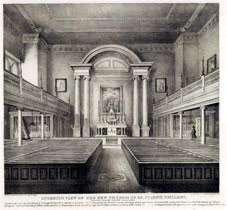
Interior, New Church of St. Joseph, 1840. Alfred Hoffy, artist; P.S. Duval, printer.
Barbelin was immediately involved in building the present church on the site of the 1757 church, and solicited funds from door to door throughout the city. Built in 1838-39, it was an unadorned “Gothicized” brick building, 75′ X 65′, with a full basement and attic. It was designed by master builder John Darragh, a parishioner. The original church had plain box pews and clear glass windows with Gothic arches. The church retains its Gothic windows in the south tower, its 1839 Corrie tracker organ case, and the Crucifixion altar painting by parishioner Sylvano Martinez, a local artist trained in Portugal. The church’s most distinctive feature, the altar ensemble of doubled Ionic columns surmounted by a bold curved pediment on the east wall, has remained intact for 168 years. The church was dedicated on February 9, 1839 by Bishop Francis Kenrick; Bishop John Hughes of New York, former curate at Old St. Joseph’s, was the homilist. Newspaper coverage hailed the installation of gas lights in the church.
Irish Immigration
Within a decade of the dedication of the church, St. Joseph’s agenda was set by the rush of Irish immigrants at the nearby docks. In February 1848, Fr. Barbelin invited a group of prominent Catholic gentlemen to attend a meeting at St. Joseph’s to discuss the needs of the immigrants. Out of this meeting came St. Joseph’s Society for the Relief of Irish Immigrants and the establishment of St. Joseph’s Hospital at 16th Street and Girard Avenue, which is still in operation. Shortly thereafter Fr. Barbelin purchased a lot at 17th Street and Stiles Streets near the hospital to build a “new” St. Joseph’s Church and College, (now the Church of The Gesú and St. Joseph’s Preparatory School). It was at that time that the church in Willings Alley became known as “Old” St. Joseph’s.
Apostle of Education
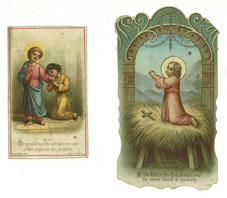
Holy Cards, St. Joseph’s Sunday School. OSJ archives.
Father Barbelin was Old St. Joseph’s apostle of education. By mid-century, the basic educational needs of the Catholic community were being met by four parochial schools (two free, two required tuition), an adult night school, a private St. Joseph’s Academy for Young Ladies operated by the Sisters of St. Joseph, and a “Classical Academy” north of the church. Father Barbelin was known throughout the city, however, as the “Apostle of the Sunday School.” St. Joseph’s Sunday School attracted youngsters from throughout the city, enrolling over 1,000 youngsters for many decades. The need for a Catholic college was apparent. With a Catholic population in the city of 136,000, there was no Catholic secondary school or college. Two buildings fronting on Willings Alley were purchased and in 1851 the clergy house was expanded to Willings Alley and increased to four floors to accommodate a college. Father Barbelin was the first president. Both St. Joseph’s University and St. Joseph’s Preparatory School trace their founding to Willings Alley.
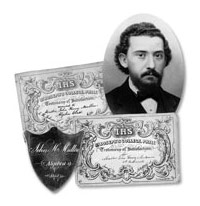
John H. Mullen, St. Joseph’s College student, 1853, with academic awards. St. Joseph’s University archives.
The college relocated near the Jesuit Church of The Gesú in north Philadelphia in 1889 under the presidency of Rev. Burchard Villiger, S.J. In 1918 St. Joseph College and St. Joseph’s Preparatory School were separated, and in 1927 the college moved to its present 103-acre campus on City Avenue. St. Joseph’s University now enrolls over 7,000 students in its undergraduate and graduate programs, and celebrated its 150th Anniversary in 2001. St. Joseph’s Preparatory School remains in north Philadelphia and enrolls 950 students. Father Barbelin’s leadership in education was recognized in 1852 when he chaired a diocesan committee organized by Bishop John Neumann (now St. John Neumann) to consider the need for parochial schools after the Nativist riots. Although there were multiple causes for the riots, one of the volatile issues was Bishop Kenrick’s request that Catholic children in public schools be allowed to read from the Catholic Bible, which exacerbated the anti-Catholic and anti-foreign sentiments of the press and local pamphleteers. Father Barbelin’s reputation as an educator made him the ideal choice to head the bishop’s committee on the need for parish schools. He had recently opened St. Joseph’s College in Willings Alley, and his church and person were unharmed during the riots, due perhaps to his reputation throughout the city for piety and discretion. The bishop’s committee led to the establishment of the first Diocesan Board of Education in 1852, and the promulgation by the United States Bishops at its First Plenary Council in Baltimore that same year that parochial schools should be erected in every parish.
Parish Life at Mid-century
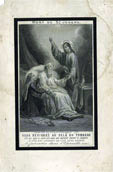
Funeral Card, Rev. Felix J. Barbelin, S.J. OSJ archives.
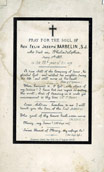
Funeral Card, Rev. Felix J. Barbelin, S.J. OSJ archives.
Vivid details of parish life at mid-century are available in the Sunday Pulpit Announcements from 1848-53 deposited in our archives. Perhaps the earliest pulpit announcements in the nation, they are in Fr. Barbelin’s hand and give us a weekly summary of parish activities and events at Old St. Joseph’s. Each Sunday announcement began with prayers for the sick and those who had died, banns of marriage, and “Saints of the Week.” The announcements document the formation of temperance groups, meetings of the Holy Family Society for “Colored” Catholics, the opening of a night school for adults, the availability of a parish lending library, the formation of the St. Vincent de Paul Society to provide food, clothing and fuel to the immigrants, and the date of the annual Mission/Retreat. Committees were formed to solicit funds to support the seminary and build the new Cathedral. Charity sermons were scheduled for the Indian missions, St. Ann’s Home for Widows, the House of the Good Shepherd (for “fallen” women), St. Joseph’s Hospital and St. Joseph’s Orphanage. Funds were solicited regularly by visiting bishops from the west and pastors building new churches. Instructions were given in the parish hall in French, German and Italian. Devotions were announced for the Bona Mors Society, the Month of Mary, the Sodalities, the Confraternity of the Holy Scapular, the Holy Rosary Society, and novenas to St. Joseph, St. Patrick, St. Francis Xavier, St. Ignatius and the Sacred Heart.
St. M. Magdalen de Pazzi, First Italian National Parish
By mid-century, Father Barbelin reached out to newly-arrived Italian immigrants. Instructions and services were provided in the parish hall. On March 21, 1852 plans to establish a church for Italian Catholics were made at Old St. Joseph’s. Later that year, with the blessings of Bishop John Neumann, St. Mary Magdalen de Pazzi, the first Italian national parish in America, was founded in south Philadelphia.
African Americans at Old St. Joseph’s
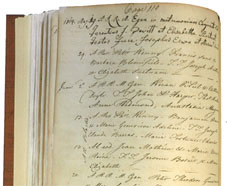
John H. Mullen, St. Joseph’s Marriages of blacks, OSJ Sacramental Records. OSJ archives.
Blacks attended Old St. Joseph’s from the beginning. Several Catholic families owned slaves who were baptized here, and St. Mary’s Charity School educated blacks in the early 19th century. Our sacramental records indicate many black refugees from Santo Domingo were baptized and married at Old St. Joseph’s. By the 1850s, there was a Sunday Mass and Vespers for the group in the parish hall, presided over by Rev. Thomas Lilly, S.J. Recent research has revealed that some of these black families rented pews in St. Joseph’s gallery during this time. In 1859 a school for black children was established on Lombard Street with 75 pupils with lay teachers. Later the Oblates of Providence from Baltimore staffed the school. This school, later moved to larger quarters purchased by St. Katharine Drexel, became the nucleus for St. Peter Claver’s Church and school in the 1880s.
Francis A. Drexel Bequest; 1886 Renovation of Church
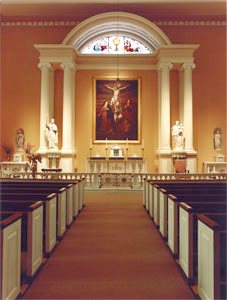
Present Interior of Old St. Joseph’s Church.
After Father Barbelin’s death in 1869, Rev. P. Aloysius Jordan, S.J., who was born in the parish and served here for thirty years, took over many of Father Barbelin’s initiatives, but the parish was changing. Banks, brokerage houses, wholesale markets and warehouses pushed residents westward and toward the suburbs. Rev. Joseph Ardia, S.J., was pastor during the transition, 1874-1885. His friendship with financier Francis A. Drexel, the father of St. Katharine Drexel, was repaid by Drexel’s generous bequest to the church in 1886. Rev. John A. Morgan, S.J., pastor 1885-1890, was in charge of the major renovations that followed. Using Drexel funds, the church was renovated by architect John J. Deery. The gallery was cut back and its original columns were replaced with the present cast iron columns. The original box pews were replaced with Victorian seating; the Gothic arched windows were replaced; and stained glass windows were installed in the present round-headed windows. The most significant windows are the Angels Adoring the Eucharist above the altar by Alfred Godwin & Co., and The Coronation of the Virgin on the north wall. The benefactors were Theodore and Frederick Tack, local merchants, and the Thomas B. McCormick family. Important frescoes throughout the church were painted by Lorenzo Scattaglio, and the ceiling painting, The Apotheosis of St. Joseph, was painted by Filippo Costaggini, a native of Italy, who later completed the frescoes in the rotunda of the U. S. Capital begun by Constantino Brumidi.
New Ministries at Turn of the Century

Outdoor Mass, Logan Square, 1925. OSJ archives.
As residents diminished in the immediate neighborhood after the Civil War, Old St. Joseph’s widened its ministries. Rev. John Scully, S.J., pastor 1891-1901, initiated an outreach to seamen on the Delaware docks. He also joined with Dr. Lawrence Flick to establish White Haven Sanatorium in Fairhaven, PA for sufferers from tuberculosis. White Haven accepted over 25,000 patients between 1901 and 1946, when it was transferred as a gift to Jefferson Medical College. By the turn of the century, the “Irish cop” was ubiquitous in American cities. Scully seized the opportunity to serve this group by founding the League of the Sacred Heart of Catholic Policemen, Firemen and Park Guards. From 1900 until World War II, thousands of members participated in monthly services, annual parades, and League Masses, typified by the 1925 field Mass at Logan Square. Local newspapers reported 70,000 in attendance. In 1904 the present marble altar rail, brass gates, and mosaic tile floor of the sanctuary were installed by architects Walter F. Ballinger and Emile George Perrot. Funds were contributed by parish Sodalities (Marian devotional groups) throughout the city to celebrate the 50th anniversary of the promulgation of the dogma of the Immaculate Conception of Mary. A plaque in the interior of the church marks the occasion.
Acknowledgement and thanks to Martin I.J. Griffin, M. Maury Walton, Eugene Gallagher, S.J., and John M. Daley, S.J., for essays or pamphlet histories of Old St. Joseph’s.
Mass Times
Sunday at 7:30 AM, 9:30AM, 11:30 AM
Tues., Wed., & Thurs. at 12:05 PM
